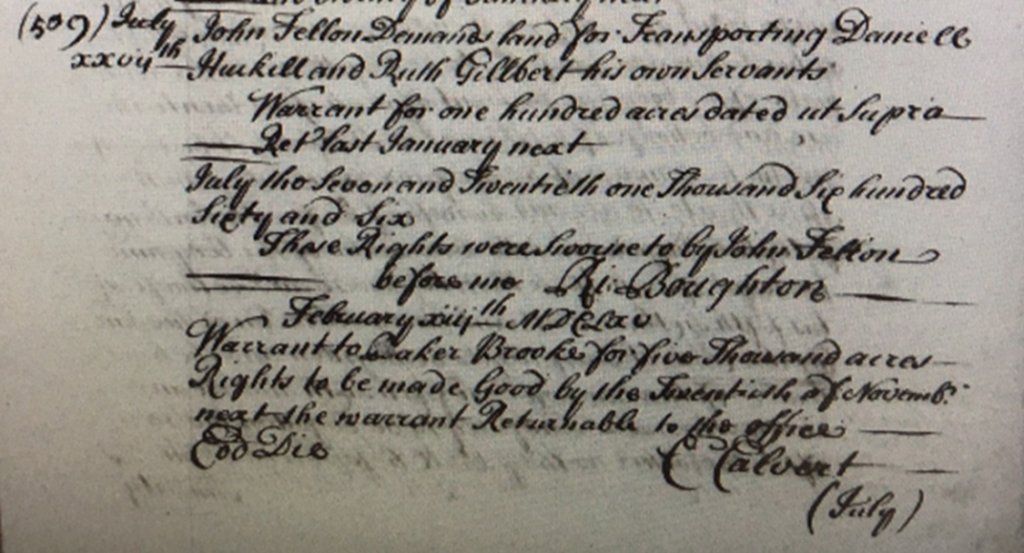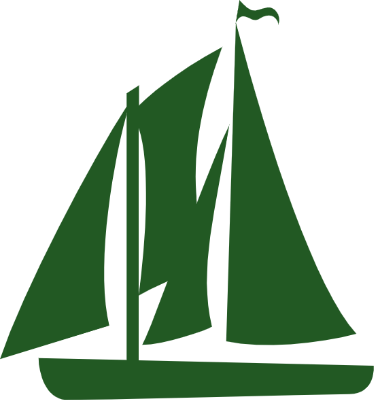1640 – 1693
Immigrant
Daniel Hukill I
“I took my leave of Albion’s Rocks: With heavy Heart, concerned that I Was forc’d my Native Soil to fly, And the Old World must bid good-buy But Heav’n ordain’ed it should be so, And to repine in vain we know; Freighted with Fools from Plymouth sound To Mary-Land our Ship was bound.”
Source: The Sot-weed Factor Or, a Voyage to Maryland A Satyr Ebenezer Cooke 1667-1732?
Daniel Felton Transports “his own” Servants
The year was “One Thousand, Six hundred, Sixty and Six,” or as we express it today, “1666” and John Felton presented a demand to the Maryland colony for 100 acres of land under the Conditions of Plantation, a policy created by the first Lord Baltimore Cecilius Calvert in 1632. Felton had transported Daniell Huckill and Ruth Gilbert whom he identified as “his own servants” a somewhat unique description, as no terms of indenture or crimes are indicated by wording. The original document can be retrieved in the Maryland State Archives and is reproduced below, but it is also conveniently listed in a summary publication curated by archivist Gust Skordas (1968).

“At the beginning, one hundred acres of land were granted to or for any person, between the ages of sixteen and sixty, who came and settled in the province. But it was only a few years before the amount granted on those conditions was reduced to fifty acres. In the year 1683, the proprietor (Lord Baltimore) ceased to grant any land whatever merely on the condition of settlement, and demanded that a price at the rate of two hundred pounds of tobacco for every hundred acres should be paid, as the condition of a grant.”
Maryland as a Proprietary Province, Newton D. Mereness, 1901
About Daniel’s Master: Who are the Felton’s?
Men of means tend to be easier to trace than their servants. Maryland records show that John Felton has 250 acres surveyed, which he names Gloucestershire.
It is probably not unreasonable to surmise that Gloucestershire was a reference to John Felton’s heritage. Gloucestershire county is in Southwest England, not far from the port of Bristol. In the 17th century, this part of the Britain was largely royalist, which meant the locals stood for the King and his retinue. By contrast, the belligerents of the era believed the King’s religion was corrupt, and that he had not a divine right to rule the kingdom. The polarity of views led to multiple Civil Wars between 1642 and 1651. Towards the end of the infighting, King Charles I lost, and was eventually beheaded in 1649. Subsequently, Oliver Cromwell, who was the leader of the Parliamentarians or Roundheads established a commonwealth government which survived until 1660, when the King’s son Charles II returned to the throne. Historians refer to this eleven-year gap between the royal authorities as the Interregnum. It is possible to consider that Daniel may have spent at least some of his life in Gloucestershire around this time, as servants are generally associated with the regions from which their masters hail.
Interestingly, young John Felton is in the Maryland records as early as 1651, which roughly corresponds to when royalists lost their estates to the Cromwell’s Army. During and after the wars, royalist family lands and castles became so many spoils of war. John Felton like other men of his generation may have left to speculate in the colonies to protect whatever remained of his family’s liquid assets. Alternatively, John Felton may have sought his future in Maryland because he was not the eldest son in the birth order. For more about the historic migration of royalist “cavaliers” from southwest England to Mid-Atlantic America, see Albion’s Seed (1989). (Albion is a poetic reference to one of the earliest known names for the island of Britain).
Significantly, there are disparate branches of the Felton family. As is typical of civil wars, brothers can take up arms against brothers. This may have happened to the Felton’s. In addition to the Felton’s of southwest England, there appear to be Felton relations to the northern portion of England who supported Cromwell’s cause of purifying the English King’s religion (hence the label of Puritan). That side of the Felton family ended-up in Boston.

Where did the Felton’s Settle in Maryland ?
Initially John Felton has patents on the Patuxent River. In addition to Gloucestershire, he had other estates which he named Rich Ridge and Felton’s Lott. The mouth of the Patuxent is on the opposite side of the small peninsula that is also home to St Mary’s City—off the Potomac River. St Mary’s had been established as the home base for colonial Maryland back in 1633. John Felton was settled enough such that within a few years that he sends for his wife Katherine, who arrives sometime between 1653 and 1657. Tobacco and the fur trade dominate the early Tobacco Coast economy of Maryland. By 1665, Felton expands his interests to lands across the Chesapeake Bay, to the area that is about to become Dorchester County in 1668. During this latter period Felton transports “his servants,” Daniel Huckill and Ruth Gilbert. Significantly, this is about 15 years after he first came to Maryland. (The timing suggests that more research is useful.)
About 20 years after John Felton first stepped foot into the New World, he dies. Records place his death somewhere between 1671 and 1673. His widow Katherine promptly remarries, to John Phillips. Felton’s name can be found in the History of Dorchester (1902) and his estate records are in the Maryland Calendar of Wills.

From Servant to Planter in a Generation
Daniel Huckill, the servant and immigrant, is estimated to have been born in 1640, so he would have been 26 when he is transported to Maryland. Approximately a handful of years later, coincident with John Felton’s death, Daniel becomes the father of the first of three sons, Daniel 2, followed by Michael and Richard. Daniel, the immigrant, goes on to live a relatively long life for servant in colonial Maryland–dying at the age of 53 in 1693.
Some thirty-eight years after Daniel’s death in 1693, his first-born son Daniel 2 formally appears in Maryland’s property records. Son Daniel is identified as a planter of tobacco and along with an apple orchard on a modest parcel of land further up the Bay along the eastern shore of the Chesapeake. In a single generation, the son of a servant has established a new provenance between Chesapeake Bay and Delaware River. A direct line of Daniel’s descendants continues to live in the area for the next 350 years, but many descendants also leave. Siblings and cousins of subsequent generations pioneer their way into the wild interior of the new world—crossing the Allegheny’s, heading up to Fort Duquesne (now Pittsburgh) and cruising down the Ohio River to find their way West.

“For know, that the Servants here in Mary-Land of all Colonies, distant or remote Plantations, have the least cause to complain, either for strictness of Servitude, want of Provisions, or need of Apparel. “
George Alsop
References
Alsop, G. (1666). A character on the province of Maryland. Reprint 1902. Cleveland, OH. The Imperial Press. Burrows Bros Company.
Dupell, K. (2012). John and Katherine Felton. Genealogy.com. https://www.genealogy.com/forum/surnames/topics/felton/1327/
Fischer, D.H (1989) Albion’s seed. New York, NY, Oxford University Press. p 207.
Hemmings, D. (2009) Felton family origins. Genealogy.com. https://www.genealogy.com/forum/surnames/topics/felton/1178/
Jones, E. (1902). The history of Dorchester County, Maryland. Williams &Wilkins Co. p.31.
Mereness, N.D (1901). Maryland as a proprietary province. Reprint 1997 Bowie, MD. Heritage Books, Inc. p.77.
Middleton, A.E. (1984). Tobacco coast: A maritime history of Chesapeake Bay in the colonial era. Baltimore, MD. Johns Hopkins University press.
MSA 4341. EE 509 Film no. Transported 1666. Transcript 9:505.
Skordas, G. (Ed.). (1968). The early settlers of Maryland. Baltimore, MD. Genealogical Publishing Co. p.243
